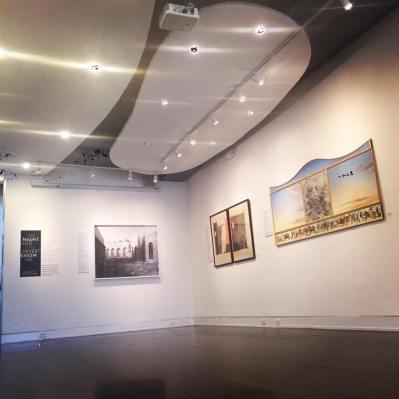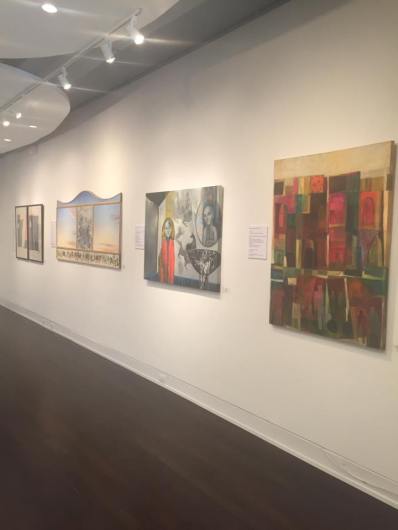One of the most discomfiting images in the “Night and the Desert Know Me” exhibition at the Joan Hisaoka Healing Arts Gallery in D.C. is Michael Platt’s “Just Outside My Window #1”:

Photo: courtesy Joan Hisaoka Healing Arts Gallery.
Each of the works in the exhibition is a response to an Iraqi poem. Platt’s “Just Outside” transforms Abd al-Wahhab al-Bayati’s (1926-1999) “An Apology for a Short Speech.” On its own, “An Apology” is a poem about Iraqi leadership — al-Bayati was at odds with a number of Iraqi rulers and had his citizenship revoked by Saddam Hussein. Beside Platt’s work, “An Apology” becomes a poem about the US-led Occupation of Iraq.
From al-Bayati’s translated poem:
My speech is short
yet I am not drunk
but I do laugh
at my agony
though I am not a Caesar
but Rome is burning
my soul suffocating
among thousands of betrayals, thousands of
dirty
lies.
Beside the poem, instead of an image of a Saddam-like speech-maker, Platt’s archival inkjet print foregrounds a US soldier holding the body of a young child. Perhaps this helmet-wearing American soldier is rescuing the child, or comforting the child, or perhaps he is simply moving a corpse. A young girl stands above him, unprotected in a doorway, peering down on him as she melts in and out of the door.

Photo: courtesy Joan Hisaoka Healing Arts Gallery.
Without feeling polemical or forced, Platt’s is the most explicitly political piece in the collection. It leaves just enough about the soldier unsaid to give the viewer space to construct their own readings.
The other thirteen pieces also respond to poetic works selected by Mary Sebold. The poems and poem-fragments range from B.C.E. Gilgamesh, to 10th-century Mutanabbi, to twentieth-century poetic renovators Nazik al-Malaika and Badr Shakir al-Sayyab, to contemporary poets like Sargon Boulus and Dunya Mikhail.
“Just Outside My Window #1” is not the only piece that takes an older poem and places it against a new, violent context. Wafaa Bilal’s iconic “The Ashes Series: Al-Mutanabbi Street” presents a photograph of a “flood” of contemporary-looking books and rubble alongside Nazik al-Malaika’s “The Passionate River,” which was a poetic response to Baghdad’s 1954 flood.
In a few cases, two artistic works respond to a single poem: Shakir Al Alousi and Ahmed Alkarkhi both respond to al-Sayyab’s seminal, moving “Rain Song,” with Alkarkhi titling his piece an adapted “Rain Song USA.” Al Alousi’s smaller painting is bright with nostalgic color, and his figureless landscape jumps with the rhythmic movement of al-Sayyab’s “Drip, drop, the rain / Drip, drop, the rain.” Alkharkhi’s piece meanwhile is much darker. It uses a collage of printed texts and writing at the edges of a village scene. There are three unnerving women at the center — muses or witches or sisters — their mouths open, possibly singing a “Rain Song USA.”
Vian Sora had two responses to Kajal Ahmed’s short poem “The Mirror,” which was translated from the Kurdish by Darya Ali and Alana Marie Levinson-LaBrosse. In one, a figure stands near a mirror image of himself, and, in the background, horsemen with spears ride by and beasts seem to fight one another. In Sora’s other response, “City Face,” there is a greater confusion of selves and beasts and leakages.

“Diogenes,” by Qais Al Sindy. Photo: courtesy Joan Hisaoka Healing Arts Gallery.
Some of the poems must have been read only in their English translations; however, artist Qais Al Sindy writes in his artist’s statement about “Diogenes,” which was a response to Lamiah Abbas Imara’s poem of the same name, that he met with the poet and had her read him the work in Arabic. His reaction, pictured right, feels closer to the poem than Mawada Allak’s response, “Infinity.”
Each piece deserves its own exploration: Mutanabbi’s poem, from which the exhibition takes its name, is in Arthur Wormhoudt’s translation. It gets a surprising response from Phyllis Plattner’s “Chronicle of War/Skies,” where a close-up of war is set against two panels of soft, open skies. Plattner wrote, in her statement, that the work could be seen as “political art,” but “they are also meditations on the stunning contrasts within the human heart.”
Spencer Dormitzer, who responded to Dunya Mikhail’s “Iraqis and Other Monsters” with his “Fortresses and Other Fortresses (And Other Fortresses)”, will speak about the process of translating a poem into visual expression, alongside Mikhail, on March 4.
The exhibition opened on January 15, and there will be several more events before it closes March 5:
Al-Mutanabbi Street Starts Here 2016 Curators Talk: Tuesday, February 9, 6:30-8:00 p.m.
The Night and the Desert Know Me Curator and Artist Talk: Saturday, February 13, 3:30-5:30 p.m.
A Picture of the World With You Inside – An Evening of Poetry with Dunya Mikhail (and Spencer Dormitzer): Friday March 4, 6:00-8:00 p.m.
Translation Workshop with Kareem James Abu-Zeid: Saturday, March 5, 1:00-4:00 p.m.
The exhibtion and events are part of “Al Mutanabbi Street Starts Here DC 2016.” Related events are happening throughout Washington, D.C.; you can find details on the www.amsshdc2016.org website.
Click HERE to read more

Be the first to comment